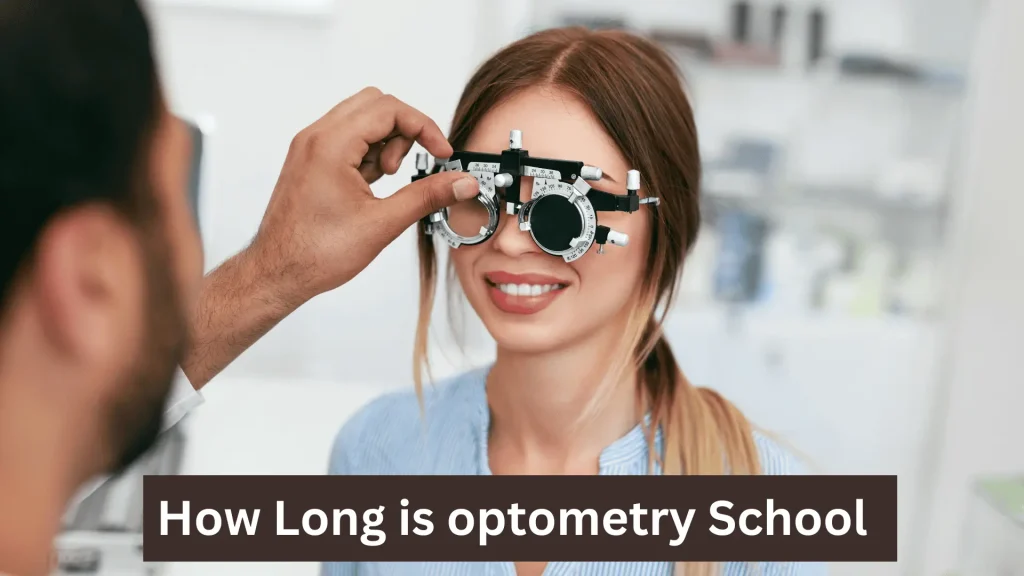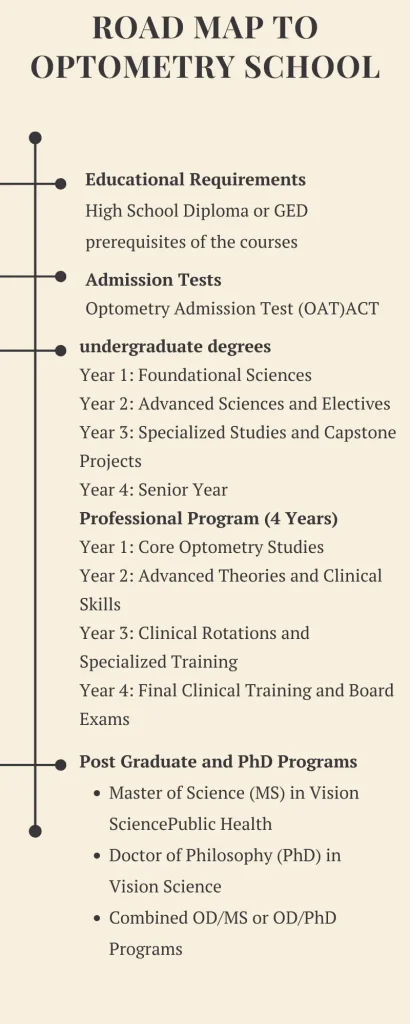How Long is Optometry School
Are you considering a career in optometry and wondering, how long is optometry school? Becoming an optometrist involves a substantial educational commitment, typically spanning seven to eight years. This guide will walk you through the journey, from undergraduate studies to obtaining your Doctor of Optometry (OD) degree.
What is Optometry School?
Optometry school is a professional educational program designed to prepare students for careers as optometrists. Optometrists are healthcare professionals specializing in eye and vision care, diagnosing and treating visual problems, and managing diseases, injuries, and other disorders of the eyes. They play a crucial role in maintaining overall eye health and often work in various settings, including private practices, corporate vision centers, and healthcare facilities.

In optometry school, students undergo rigorous training that combines theoretical knowledge with practical skills. The curriculum covers a wide range of topics, including anatomy, physiology, pharmacology, optics, vision science, and clinical practice. This comprehensive education equips future optometrists with the expertise needed to provide high-quality eye care to their patients.
How Long is Optometry School?
Undergraduate Program (3-4 Years)
Before entering optometry school, students must complete an undergraduate program, typically taking three to four years. Some schools, like the Massachusetts College of Pharmacy and Health Sciences (MCPHS), offer accelerated pathways allowing students to complete their undergraduate studies in three years.
Year 1: Foundational Sciences
Courses: General Biology, General Chemistry, and introductory courses in humanities and behavioral sciences.
Focus: Building a strong base in the sciences and gaining initial exposure to the field of optometry.
Year 2: Advanced Sciences and Electives
Courses: Organic Chemistry, Physics, and electives tailored to the student’s interests.
Focus: Deepening knowledge in essential scientific areas and exploring specific topics related to optometry.
Year 3: Specialized Studies and Capstone Projects
Courses: Advanced anatomy, cellular biochemistry, physiology, medical microbiology, and healthcare ethics.
Focus: Preparing for professional studies through specialized courses and capstone projects, culminating in an interview for the Doctor of Optometry program.
Professional Program (4 Years)
After completing the undergraduate program, students advance to the Doctor of Optometry (OD) program, which typically lasts four years.
Year 1: Core Optometry Studies
Courses: Optometry theory, pharmacology, anatomy, and physiology.
Focus: Establishing foundational knowledge in optometry and beginning hands-on lab work.
Year 2: Advanced Theories and Clinical Skills
Courses: Advanced optometry theories and clinical methods.
Focus: Enhancing clinical skills through varied coursework and practical labs.
Year 3: Clinical Rotations and Specialized Training
Activities: Clinical rotations in optometry school facilities and with practicing optometrists.
Focus: Gaining hands-on experience in real-world settings and specializing in areas like pediatric optometry or low vision therapy.
Year 4: Final Clinical Training and Board Exams
Activities: Final clinical rotations and preparation for board exams.
Focus: Completing practical training and passing board certification exams to become a licensed optometrist.

How to Enter Optometry School
Educational Requirements
To enter optometry school, students must complete a pre-professional undergraduate education. Common prerequisites include:
General Biology (1 year)
General Chemistry (1 year)
Organic Chemistry (1 year)
Physics (1 year)
Calculus (1 semester)
Statistics (1 semester)
English (1 year)
Biochemistry (1 semester)
Microbiology (1 semester)
Human Anatomy and Physiology (1 semester)
Entry Tests
Prospective students must take the Optometry Admission Test (OAT), a computerized exam that evaluates knowledge in natural sciences, reading comprehension, physics, and quantitative reasoning. The OAT is a critical component of the application process and requires thorough preparation.
Application Process
The application process typically involves:
Submission of Transcripts: Official transcripts from all attended educational institutions.
Letters of Recommendation: Usually from academic advisors, science teachers, or practicing optometrists.
Personal Statement: An essay outlining the applicant’s interest in optometry and career goals.
OptomCAS Application: A centralized application service for optometry schools.
Financial Aid
Various financial aid options are available to optometry students, including scholarships, grants, and loans. Many schools offer need-based and merit-based scholarships to help offset the cost of education. Additionally, federal student aid programs, such as the FAFSA, can provide loans and grants to eligible students.
By following this pathway, you can achieve your dream of becoming an optometrist. Remember, the journey requires dedication, hard work, and a passion for eye care.
Post Graduate and PhD Programs
Specializations in Postgraduate and PhD Programs
For those interested in delving further into the “whys” and “hows” of the visual system, various graduate degree programs in optometry are available. These programs are typically research-oriented and offer specializations such as:
Master of Science (MS) in Vision Science: Focuses on advanced study and research in the visual and ocular system.
Doctor of Philosophy (PhD) in Vision Science: Emphasizes in-depth research, often culminating in a dissertation that contributes new knowledge to the field of optometry.
Combined OD/MS or OD/PhD Programs: These dual degree programs allow students to concurrently earn both their Doctor of Optometry (OD) and a graduate degree in vision science.
These programs are designed for individuals aiming to pursue careers in academia, research, or specialized clinical practices.
Top 10 Optometry Schools

University of California-Berkeley, School of Optometry
Courses: OD Program, Vision Science PhD .
State University of New York, College of Optometry
Courses: OD Program, MS in Vision Science, PhD in Vision Science.
University of Houston, College of Optometry
Courses: OD Program, MS in Physiological Optics/Vision Science, PhD in Physiological Optics/Vision Science.
University of Alabama at Birmingham, School of Optometry
Courses: OD Program, Vision Science PhD.
Southern California College of Optometry at Marshall B. Ketchum University
Courses: OD Program.
Ohio State University, College of Optometry
Courses: OD Program, Vision Science PhD.
New England College of Optometry
Courses: OD Program, MS in Vision Science.
Pacific University, College of Optometry
Courses: OD Program, MS in Vision Science, PhD in Vision Science.
Indiana University, College of Optometry
Courses: OD Program.
Southern College of Optometry
Courses: OD Program.
These institutions are renowned for their rigorous academic programs, research opportunities, and clinical training facilities.
Factors Affecting the Length of Optometry School
Undergraduate Education Duration: The length of undergraduate studies can vary from three to four years depending on the program and the student’s pace.
Accelerated Programs: Some institutions offer accelerated pathways that can shorten the total duration of education.
Clinical Residencies: Optional residencies after the OD program can add an additional year of specialized training.
Dual Degree Programs: Pursuing dual degrees (e.g., OD/MS, OD/PhD) can extend the time spent in school.
Part-Time Study: Optometry schools may offer part-time study options, which can lengthen the duration to complete the program.
Final Verdict
In conclusion, how long is optometry school. The journey to becoming an optometrist typically involves 3-4 years of undergraduate education, 4 years of professional optometry school, Optional 1-year clinical residency or additional graduate studies. The total duration can range from seven to nine years, depending on the path chosen. This comprehensive education ensures that optometrists are well-prepared to provide excellent eye care and address various visual health issues.
FAQs
1. What undergraduate courses are required for optometry school?
To enter optometry school, students usually need to complete courses in General Biology, General Chemistry, Organic Chemistry, Physics, Calculus, Statistics, English, Biochemistry, Microbiology, and Human Anatomy and Physiology.
2. How important is the Optometry Admission Test (OAT)?
The OAT is crucial as it assesses a candidate’s knowledge in natural sciences, reading comprehension, physics, and quantitative reasoning. A strong score can significantly enhance an applicant’s chances of being accepted into optometry school.
3. Are there financial aid options available for optometry students?
Yes, various financial aid options are available, including scholarships, grants, and federal student loans. Schools often have need-based and merit-based scholarships to help students manage the cost of education.
4. Can I specialize in a particular area of optometry?
Yes, after completing the OD program, optometrists can pursue clinical residencies in specialties such as ocular disease, pediatric optometry, or vision therapy.
5. What is the job outlook for optometrists?
The demand for optometrists is expected to grow due to an aging population and increasing awareness of eye health. Optometrists can work in various settings, including private practices, hospitals, and research institutions.
